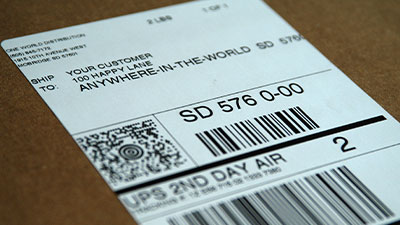In This Article:
Shipping protection is an essential part of ecommerce logistics. As businesses increasingly rely on global shipping to meet consumer demands, the question arises: Is shipping protection worth it? Shipping insurance can safeguard your business against unforeseen circumstances but are the added costs worth the risk?
For many ecommerce businesses, shipping protection is not just an optional add-on but a necessity. It covers potential losses and damages during transit, which can devastate a business’s bottom line if left unaddressed. In an era where customer satisfaction depends on timely and intact deliveries, ensuring that goods reach their destination without incident is crucial.
Since we’ve been an ecommerce 3PL for more than thirty years, we can help simplify the complexities of shipping insurance and explore how to use it for businesses of all sizes. By looking at different factors like coverage options, costs, and strategic benefits, we’ll help you decide whether shipping protection should be part of your logistics plan.
Understanding Shipping Insurance
Shipping insurance is a safeguard for ecommerce businesses, shielding them against potential financial loss due to damaged or lost shipments. Whether you’re sending a single package or managing large-scale logistics, having shipping insurance in place ensures that you are protected from unforeseen transit mishaps.
What is Shipping Insurance?
Shipping insurance refers to a policy that provides coverage for goods being transported from one location to another. It compensates the shipper or receiver in case of loss, theft, or damage during transit. Unlike basic carrier liability, which often covers only a fraction of the item’s value, shipping insurance can be tailored to cover the full value of the cargo.
Importance in Global Trade
Global trade hinges on the seamless movement of goods across borders. Shipping insurance plays a pivotal role in this ecosystem by:
- Mitigating financial risks associated with international shipping.
- Enabling businesses to enter into new markets confidently.
- Ensuring customer satisfaction through reliable delivery guarantees.
How Shipping Insurance Works
Understanding the details of shipping insurance is important for making smart choices in logistics and managing risks. The global shipping insurance market size reached 30.39 billion USD in 2023 and experts predict it will hit 79.09 billion USD by 2032. Learning about how shipping insurance works helps us understand the processes involved, how claims are handled, and any potential policy exclusions that could affect our business.
Operational Mechanics
Shipping insurance acts as a safety net against possible losses that may occur during transportation. When you buy a shipping insurance policy, you’re basically shifting the responsibility of bearing financial losses caused by damage or loss of goods onto the insurer. This protection is crucial for businesses involved in international fulfillment and trade where risks are heightened due to long distances and multiple points of handling.
Here’s how it works:
- Insurance Policy Issuance: Once both parties agree on the terms, the insurer issues a policy that outlines the specifics of coverage.
- Coverage Activation: The coverage comes into effect once the goods are shipped and remains active throughout transit until delivery.
- Risk Assessment: Insurers evaluate the level of risk based on factors such as cargo value, route risk, and historical data in order to determine premiums.
Claims Process
When unfortunate incidents happen, knowing how to navigate the claims process ensures quick resolution:
- Incident Reporting: Immediately inform your insurer about any loss or damage that has occurred.
- Documentation Submission: Provide all necessary documents including a copy of the insurance policy, commercial invoice, packing list, and bill of lading.
- Damage Evaluation: The insurer may require a surveyor’s report in order to assess the extent of damage.
- Claim Review: The insurer will review all submitted information to verify the validity of the claim.
- Reimbursement or Repair Authorization: If approved, insurers will either reimburse the insured value or authorize repair costs.
Timely communication and thorough documentation help speed up the claims process, minimizing disruptions in your supply chain.
Policy Exclusions and Limitations
While shipping insurance provides extensive protection, it’s important to be aware of any exclusions in your policy:
- Inherent Vice: Damage caused by inherent defects or qualities in goods (e.g., perishable items spoiling) is usually not covered.
- Improper Packaging: Claims resulting from inadequate packaging are not included in the coverage.
- Acts of God: Natural disasters such as earthquakes may be excluded unless explicitly mentioned in the policy.
- War Risks: Many policies do not cover damages related to war or civil unrest unless additional coverage is purchased.
Protect your business interests against unexpected disruptions during transit and start setting policies for your business to prepare for potential claims scenarios. Take it from us; you never truly know what can happen during transit so it’s best to ready for the worst.
Coverage Details: What Does Shipping Insurance Cover?
Shipping insurance, a crucial safeguard for ecommerce businesses, offers a safety net against unexpected losses during transit. Understanding the specific coverage details can help you know if it’s worth the investment.
Categories of Coverage
1. Cargo Insurance
Definition: Protects goods in transit against loss or damage.
Risks Covered:
- Theft: Protection against stolen goods during transportation.
- Damage: Coverage for physical harm caused to cargo during handling or transit.
- Non-Delivery: Compensation if the cargo fails to reach its destination.
2. Hull Insurance
Definition: Pertains primarily to shipping vessels, covering loss or damage to the ship itself.
Risks Covered:
- Collision Damage: Costs associated with repairing or replacing parts of the vessel following an accident.
- Weather Impact: Protection from damages due to severe weather conditions like storms or hurricanes.
3. Liability Insurance
Definition: Provides coverage for legal liabilities arising from damage caused by the shipping operation.
Risks Covered:
- Third-Party Damages: Compensation for damages inflicted on third-party property or individuals during the shipping process.
- Environmental Hazards: Liability coverage for pollution or environmental damage caused by the vessel.
Specific Risks Addressed
- Loss During Transit: Comprehensive protection ensures compensation for entire shipments lost due to unforeseen circumstances.
- Damage During Handling: Covers mishandling or accidents that occur while loading, unloading, and transporting goods.
By closely examining what shipping insurance covers, businesses can minimize potential financial setbacks and enhance operational resilience. This detailed understanding empowers you to craft a robust risk management strategy, ensuring your logistics remain seamless and worry-free.
Costs Involved in Shipping Insurance
Understanding the costs associated with shipping insurance is critical for any ecommerce business. The question “how much does shipping insurance cost?” often arises, and the answer is contingent upon several key factors that influence pricing.
Factors that Influence Shipping Insurance Costs
- Cargo Value: The intrinsic value of the goods being shipped significantly affects insurance costs. High-value shipments typically attract higher premiums due to the increased risk of loss or damage.
- Route Risks: Different shipping routes carry varying levels of risk. For instance, routes prone to piracy or severe weather conditions may result in higher insurance costs.
- Type of Cargo: Fragile or perishable items generally incur higher insurance rates due to their susceptibility to damage during transit.
- Shipping Distance: Longer shipping distances can elevate costs as they increase the potential for something to go wrong during transit.
- Carrier Reliability: The reputation and reliability of the shipping carrier also play a role; more dependable carriers might offer lower insurance rates.
Average Pricing Examples
- Domestic Shipments: Rates might range from 0.3% to 0.5% of the cargo’s declared value.
- International Shipments: These often start at around 0.5% and can go up significantly based on risk factors mentioned above.
For instance, insuring a $10,000 shipment on an international route with moderate risk could potentially cost between $50 and $75.
Additional Considerations
Ecommerce businesses should compare different insurers’ offerings to find the most cost-effective solution that aligns with their specific needs. Understanding these cost factors empowers businesses to make informed decisions about their logistics strategy, ensuring both efficiency and protection against potential losses during transit.
Recognizing these elements allows you to strategically navigate through various shipping insurance options, optimizing your operational budget while safeguarding your assets effectively. You can offset shipping insurance expenses with a smarter approach to inventory management, using AI logistics solutions, and other tactics to improve your net profit margins. Choosing the right 3PL provider can make all the difference so it’s crucial you do your research.
Exploring Cheapest Shipping Insurance Options for Small Businesses
When considering shipping insurance, small businesses often seek cost-effective solutions that provide adequate protection without straining their budget. Several options cater specifically to these needs, offering competitive rates while ensuring comprehensive coverage.
1. Basic Coverage Plans
Many insurers offer basic policies that focus on essential protections such as loss or damage during transit. These plans typically come with lower premiums, making them an attractive choice for startups and small enterprises.
2. Flat Rate Shipping Insurance
Some providers offer flat rate insurance options, which can be particularly beneficial for businesses with consistent shipment sizes and values. This approach simplifies budgeting and aligns with the predictable shipping needs of smaller operations.
3. Online Platforms
Digital platforms like InsureShip or Shipsurance specialize in providing affordable rates by leveraging technology to streamline the insurance process. These platforms often feature user-friendly interfaces and straightforward claim procedures, adding convenience alongside cost savings.
4. Carrier Discounts
Partnering with carriers that offer discounted insurance rates as part of a bundled service can also yield additional savings. Companies like UPS and FedEx sometimes provide reduced rates for small business clients who meet certain shipping volumes or contractual commitments.
Comparing these budget-friendly options with premium services is crucial to making an informed decision. While premium plans may offer enhanced coverages such as expedited claims processing or higher liability limits, small businesses must weigh these benefits against the cost implications.
Engaging in a thorough evaluation of both budget and premium offerings ensures you select a plan that aligns with your business’s financial strategy while safeguarding your shipments effectively.
Using Shipping Insurance Calculators Effectively
Navigating the complexities of shipping insurance can be daunting, but a shipping insurance calculator simplifies the process. Utilizing this tool effectively ensures that you make informed decisions regarding your shipping coverage needs.
How to Use a Shipping Insurance Calculator
- Input Accurate Cargo Details: Begin by entering precise information about your shipment. This includes the cargo value, dimensions, weight, and destination. Accuracy here is crucial for reliable estimates.
- Select Coverage Options: Choose the type of coverage that aligns with your risk assessment. Options may include basic coverage or more comprehensive plans encompassing loss and damage.
- Assess Route Risks: Evaluate potential risks associated with the shipping route. Some calculators allow you to input specific routes to determine risk factors that may influence insurance costs.
- Review Policy Terms: Understand policy exclusions and limitations before finalizing your choice. The calculator might provide insights into what is covered and any additional clauses worth noting.
- Compare Providers: Use the calculator’s results to compare offerings from different insurers. This comparison aids in selecting a provider that balances cost with comprehensive coverage.
Benefits of Calculating Potential Costs Before Purchase
- Cost Efficiency: Calculating potential costs upfront helps identify budget-friendly options, preventing unexpected expenses.
- Informed Decision-Making: By understanding cost implications beforehand, you can make strategic decisions on whether to opt for basic or premium services.
- Risk Management: Anticipating costs related to specific risks enables better planning and allocation of resources for risk mitigation.
Leveraging a shipping insurance calculator not only streamlines the decision-making process but also enhances your ability to tailor insurance solutions specifically suited to your unique business needs, ensuring optimal protection for your shipments.
Domestic Package Insurance vs. International Coverage Needs
Understanding the differences between domestic package insurance and international coverage is crucial for businesses dealing with the complexities of shipping protection. Each type of insurance addresses different logistical challenges and risk profiles.
Domestic Package Insurance | International Coverage |
|---|---|
Route Package Insurance: Provides a safety net for shipments within a country’s borders, often focusing on factors like theft or damage en route. | Broader Risk Spectrum: Addresses additional challenges such as customs delays, geopolitical issues, and varying legal frameworks across countries. |
Simplified Claims Process: Typically involves fewer regulatory hurdles, resulting in a quicker resolution. | Comprehensive Policies Needed: May require broader policies to cover diverse risks including marine perils or air transport hazards. |
Cost-Efficiency: Generally more affordable due to lower risks associated with domestic routes. | Higher Cost Implications: Due to increased risks and complexities, international insurance tends to be pricier. |
The choice between domestic and international shipping insurance requires careful evaluation of your business’s specific logistics pathways and risk tolerance levels. Adjusting your coverage strategy in alignment with your shipping destinations ensures optimal protection against unforeseen transit disruptions.
Carrier-Provided Options: UPS and FedEx Shipping Insurance Policies Uncovered
Understanding the specifics of shipping insurance offered by major carriers like UPS and FedEx can be crucial in creating an effective risk management strategy. Both companies have their own unique policies and pricing structures, which are important to consider when assessing the cost of shipping insurance.
Does UPS Insure Packages?
Yes, UPS provides declared value coverage as part of their shipping services. This is not insurance per se, but a liability limit that protects the shipper against loss or damage.
- Declared Value: Shippers can declare a value up to $50,000 per package.
- UPS Insurance Charges: The first $100 of declared value is included at no additional cost. Additional coverage incurs a fee, typically around $1.05 for every $100 of declared value above the initial $100.
- Limitations: Coverage does not extend to items deemed prohibited or restricted by UPS. For more details on these limitations, refer to this UPS Loss White Paper.
FedEx Insured Shipping Options
FedEx offers similar coverage through its declared value system, allowing shippers to declare a package’s worth for protection against damage or loss.
- Declared Value: Available for up to $50,000 per shipment.
- Cost Structure: Like UPS, the first $100 is free; additional coverage costs around $1.15 per $100 of declared value beyond the initial amount.
- Specific Exclusions: Items such as cash, antiques, and certain electronics may not be covered under FedEx’s insured shipping.
Cost Comparison: UPS vs. FedEx
While both carriers provide comparable services in terms of insured shipping, subtle differences exist in their cost structures and coverage specifics:
- Basic Coverage Cost: Both offer complimentary coverage for the first $100 of declared value.
- Additional Coverage Rates: UPS generally offers slightly lower rates than FedEx for additional declared values ($1.05 vs. $1.15 per $100).
For businesses weighing between these options, understanding these nuances can aid in selecting the most cost-effective and comprehensive solution tailored to specific shipping needs. It’s also crucial to follow proper packaging guidelines to ensure that items are covered under these insurance policies.
The Case for Third Party Shipping Insurance Providers
Third party shipping insurance offers an alternative to carrier-provided options, providing tailored coverage solutions for ecommerce shipments. These insurers specialize in offering comprehensive protection that aligns with the unique needs of online retailers.
Definition and Benefits:
Customized Coverage
Third party shipping insurance providers often offer more flexible policy options compared to traditional carriers. This customization allows businesses to select coverage that best suits their specific shipping requirements, including varying levels of protection based on the value and nature of the goods.
Cost Efficiency
Opting for third party insurance can result in cost savings. These providers frequently offer competitive rates by focusing solely on insurance services, which can be more economical than bundled carrier packages.
Broad Coverage
Many third party insurers provide expansive coverage that includes risks not typically covered by standard carrier policies, such as loss, theft, and damage during transit.
Streamlined Claims Process
Ecommerce businesses benefit from a simplified claims process with third party insurers. Their expertise in handling shipping-related claims ensures quicker resolutions, minimizing disruptions to operations.
By leveraging third party shipping insurance, ecommerce businesses can ensure robust protection while potentially improving service efficiency. This option empowers companies to manage risk while still keeping costs down.
Evaluating the Worthiness of Investing in Shipping Protection
The decision to invest in shipping protection is crucial for businesses involved in ecommerce. To determine if shipping protection is worth it, you need to consider its benefits and potential downsides.
Advantages of Shipping Protection:
- Risk Mitigation: Protects against financial losses due to damaged or lost goods, offering a safety net that can save your business significant amounts in unforeseen circumstances.
- Customer Assurance: Builds trust with customers by ensuring their purchases arrive intact and on time, enhancing brand reputation and customer loyalty. Having a dedicated ecommerce customer service provider can further improve shopper satisfaction.
- Operational Continuity: Minimizes disruptions caused by claims processes, allowing businesses to maintain smooth operations without major setbacks.
- Global Trade Facilitation: Essential for international shipments where risks are higher due to longer transit times and multiple handling points.
Disadvantages of Shipping Protection:
- Cost Implications: The premium cost may add up, especially for high-volume shippers or businesses dealing with low-margin items. This could impact overall profitability if not carefully managed.
- Complex Claims Process: Filing claims can be time-consuming and complex, requiring detailed documentation which might delay resolution and reimbursement.
- Policy Limitations: Coverage limitations and exclusions can leave certain goods unprotected, necessitating careful policy selection tailored to specific business needs.
Incorporating Risk Mitigation Strategies in Your Logistics Operations
Risk mitigation in logistics is a crucial component of successful ecommerce operations. With global supply chains becoming more intricate, the need for comprehensive risk management strategies has never been more urgent. Businesses must proactively address potential disruptions that could affect their logistics processes.
- Prevent Financial Losses: Unforeseen events such as natural disasters, theft, or accidents can result in significant financial losses. Effective risk management helps to minimize these losses by planning and preparing for various scenarios.
- Enhance Operational Efficiency: Identifying potential risks allows businesses to streamline logistics processes, ensuring smoother operations and timely deliveries.
- Maintain Customer Satisfaction: By mitigating risks, companies can reduce delays and errors, leading to improved customer satisfaction and loyalty.
Shipping Insurance as Part of Broader Risk Mitigation Strategies:
Shipping insurance plays a vital role in broader risk mitigation strategies for ecommerce brands. It acts as a financial safeguard against the unexpected, covering losses or damages incurred during transit. This form of protection is essential for businesses seeking to maintain uninterrupted service and protect their bottom line.
- Integration with Supply Chain Management: By incorporating shipping insurance into their logistics strategy, businesses can align it with other supply chain elements such as inventory management and transportation planning.
- Customizable Coverage Options: Tailored insurance policies allow companies to choose coverage that best fits their specific needs, whether it’s domestic package protection or international shipping solutions.
Incorporating shipping insurance into your risk mitigation plan ensures a robust defense against potential threats in the logistics landscape. By doing so, you not only protect your assets but also strengthen your overall business resilience.
Schedule a Logistics Consultation to Learn More About Shipping Insurance and Save Money on Fulfillment
Investing in adequate shipping insurance is crucial for protecting against potential losses during transit. The right coverage not only safeguards your inventory but also enhances customer satisfaction by ensuring timely and intact deliveries. To explore how comprehensive protection can elevate your business, consider scheduling a logistics consultation with OWD.
Why Choose OWD?
- Comprehensive Services: From D2C to B2B and P2C, benefit from seamless integration and global fulfillment capabilities.
- Enhanced Customer Experience: Leverage our call center services and account management for superior service.
- Tailored Solutions: Our expert team collaborates closely with you to align solutions with your business objectives, turning perceived costs into profitable opportunities. Whether you need multi-channel distribution or EDI integration, we have the infrastructure and tech you need to lower fulfillment costs while improving service.
- Personalized-to-Consumer (P2C) Fulfillment: Transform order fulfillment into a revenue-generating part of your business. With our P2C Fulfillment, offer your customers easy product personalization that opens a new money-making opportunity for your business. Shoppers can personalize your products with engravings, embroidery, or direct-to-object printing at checkout, increasing average order values while helping you generate natural word of mouth marketing.
Our team works diligently to understand your specific business needs. With our robust technology platform and extensive network of warehouses, we ensure unparalleled speed and reliability in order fulfillment. Whether you’re expanding globally or seeking streamlined operations, OWD provides the expertise and resources to support your growth.
Book your consultation today to unlock new potentials in shipping protection and fulfillment strategies.
In This Article:
Subscribe to our Newsletter
Tincidunt urna mauris eu quam vulputate lobortis sit. Purus feugiat arcu nunc quisque massa ut.



























